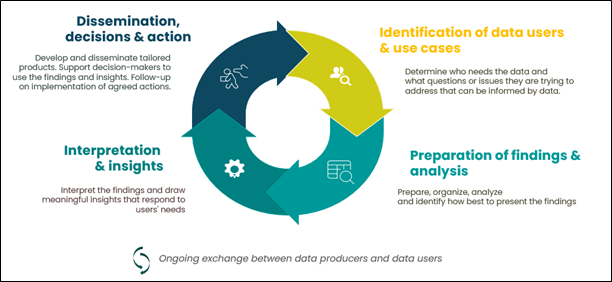22 Planning Ahead
The objective of the final session of the workshop is to identify concrete actions to take forward the work you have completed. As you have been preparing and interpreting your analyses, you have been encouraged to think about the full cycle of data-driven decision-making. (See diagram below.) This starts with identifying the data users and understanding the questions or issues they aim to address, and then preparing the findings, interpretation and insights that would be most useful for addressing those questions or issues. Information products and dissemination strategies should be tailored to align with users’ preferences and should be supplemented with support to decision-makers in utilizing the analysis and following up on agreed actions. This requires ongoing engagement between data providers and users to understand needs and to learn what is most useful in responding to those needs.
As you prepare your plans, consider your use cases and audiences, as well as the platforms and meetings that could be leveraged to reach these audiences. It will be important to do more than just share the analysis as a one-off event, so think about how to feed into routine forums where data and analyses are used, and decisions are taken. A primary use will be contributing to routine reviews of progress and performance led by the Ministry of Health, such as analytical reports for annual reviews or for global reporting on RMNCAH-N.
Consider also how this will connect with your Countdown country collaboration and existing plans to build capacity for RMNCAH data analysis and use. For instance, if you are having working sessions with your target audiences to share the findings, you could also use this as an opportunity to explore some of the concepts learned during the workshop and to strengthen competencies to interpret the analyses and identify opportunities for action (see further suggestions below). If you have participated in CAM workshops in previous years, reflect on what has worked well so far and whether there are new use cases, audiences or dissemination approaches you could explore, drawing on your experiences and those of other countries.
| Purpose of the activity | Examples |
|---|---|
| Supporting data use and action |
|
| Building capacity |
|
| Identifying needs for further analysis |
|
